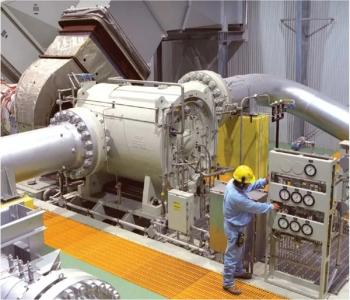
Getting To The Bottom Of Vibration Issues
In mid 2011, technicians at Kingsbury's Repair & Service Division in Hatboro, PA were consulted by the owner-operator of a 40-year-old, 114.3 MW vertical pumped storage turbine-generator located on a major river in the southwestern United States. The combination thrust and guide bearing assembly was installed beneath the generator, with a separate guide bearing assembly installed on the turbine. The 76" diameter twelve-shoe thrust bearing was designed and produced by the original equipment manufacturer and featured a Kingsbury style, pin type, mechanical load equalizing system. By design, this thrust bearing support system automatically self-aligned the bearing system and equalized the load on the individual thrust shoes. During operation, the unit had been experiencing vibration levels generally characterized as "rough", with levels occasionally so high that they led to random shut-downs. Maintenance records indicated that there had been difficulties aligning this machine within the specification guidelines for quite some time. The operator suspected the bearing system was at fault, so during a scheduled outage at the plant, he contacted Kingsbury for field service assistance in order to troubleshoot and provide corrective action. Disassembly and inspection of the thrust bearing showed evidence of binding in the mechanical equalizing system.
The mechanical equalizing system consists of twelve lower leveling plates, which contact the thrust bearing base ring with a central rocking strip, allowing the lower leveling plates to pivot. There are twelve upper leveling plates installed above and between the lower leveling plates. The upper leveling plates are supported individually in a "wing-to-wing" arrangement by the adjacent lower leveling plates through the use of cylindrical pins. The wings of the upper leveling plates and the lower leveling plates are machined to form a slot for the cylindrical pin. A thrust shoe is positioned directly above each upper leveling plate and bears against it with a spherical contact. This system is ultimately intended to provide an articulated load path from the rotor to the bearing bracket.
In this particular design, square section slots were used in the leveling plate wings, with clearance between the pins and the side walls of the slot. Markings on the cylindrical pins and leveling plate slot walls indicated random positioning of the pins, skewed pin arrangements and hard contact between the cylindrical pins and the walls of the slots. As a result, binding conditions were obvious.
Further evidence supporting the theory of leveling plate/pin binding was the manner in which the bearing bracket had been adjusted in the past. The bracket was significantly out of level with "soft feet" conditions, and the grout beneath the sole plates (bearing bracket mounting) had also deteriorated.
For the balance of the article and associated illustrations,
Contributed by: Michael J Brawley, VP Repair & Service Div, Kingsbury, Inc
Newsletter
Power your knowledge with the latest in turbine technology, engineering advances, and energy solutions—subscribe to Turbomachinery International today.




